The ancestors of the Asian pear (Taiwanese, Japanese, sand pear) are the yamanashi trees. Once, Chinese agronomists crossed a pear and an apple to create a juicy, not sour, and not overly sweet fruit. From this article, you will learn about the characteristics of the fruit, its benefits and drawbacks, how many calories it contains, and how to store it properly.
Table of contents
Characteristics of the Asian Pear
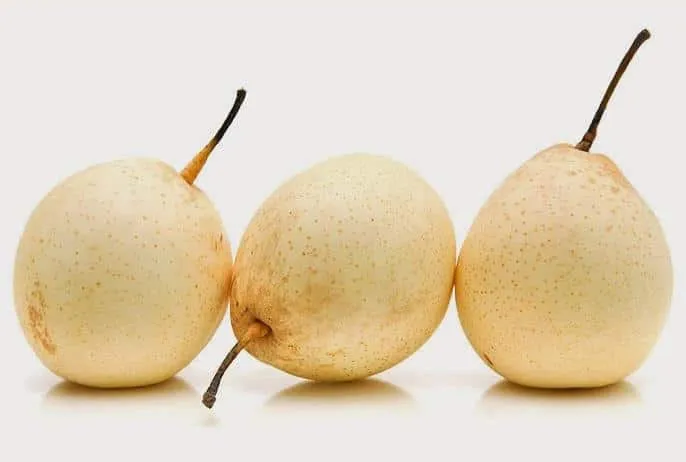
There are many varieties of Asian pears. They differ in taste, size, and ripening time. In 100 g of nashi, there are only 45 kcal. The calorie content of an Asian pear depends on its size and whether it has been cooked. The energy value of the juice is also low—45 kcal per 100 g. Dried fruit has a higher calorie count—250 kcal per 100 g, while jam made from the fruit contains 273 kcal per 100 g due to added sugar.
Nutritional value per 100 g:
- Protein – 0.5 g;
- Fat – 0.24 g;
- Carbohydrates – 7.06 g.
The ratio of protein, fat, and carbs is 5%:5%:67% of the daily recommended intake.
Note. The glycemic index of nashi is 30 (for diabetics, the safe limit is up to 50). Nutritionists recommend including Asian pears in the diet for those on weight-loss programs and allow them for people with diabetes.
Most Popular Varieties of Asian Pears in Europe
A brief description of some varieties:
- Kosui (Apple Pear). Medium-sized fruits weighing up to 160 g, with a rich bronze color and juicy flesh. 100 g of Kosui contains 45 kcal.
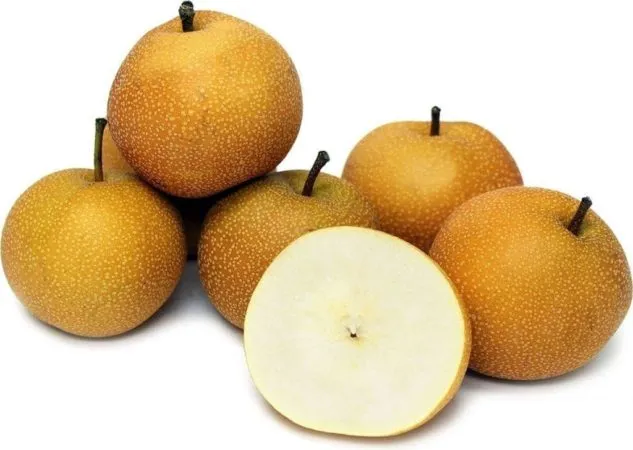
Kosui - Hosui. These pears have sweet flesh, containing 12% sugar. The fruits weigh around 200 g on average but can reach 300 g. They have a bronze-brown color and firm flesh. The calorie content is about 47 kcal per 100 g.
- Olimpic. This variety has a pleasant fruity aroma. Each fruit weighs up to 200 g, with an original taste and juicy flesh. The calorie content is about 44 kcal per 100 g.
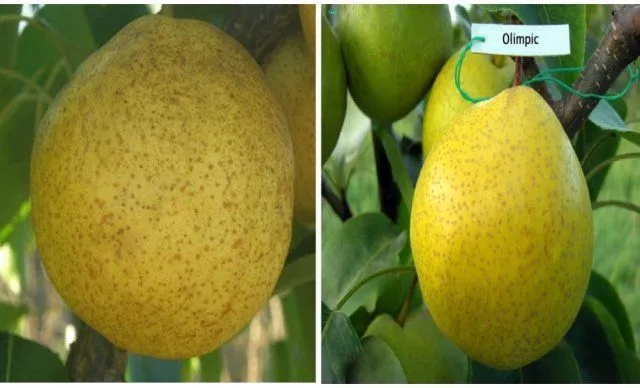
Olimpic - Crystal. Light-yellow fruits weighing 160-220 g. These pears have the lowest calorie content—42 kcal per 100 g. Their juicy flesh has a delicate taste.
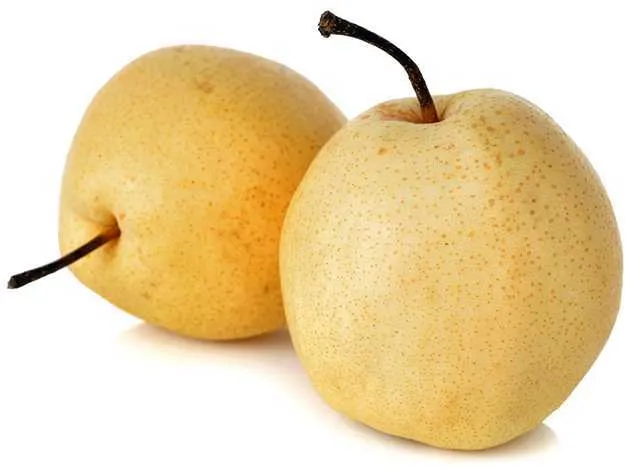
Crystal
Health Benefits of Asian Pears
Nashi pears contain a record amount of valuable minerals, vitamins, and trace elements:
- Vitamin C has antioxidant properties and boosts immunity.
- Vitamin K positively affects blood clotting.
- B vitamins stabilize nerve impulse transmission and regulate brain function.
- Vitamin B9 (folic acid) stimulates serotonin, the "happiness hormone."
- Vitamin E—the "female" vitamin—improves skin regeneration and prevents wrinkles.
- Pectin normalizes intestinal function.
- Potassium regulates the cardiovascular system, maintains water-electrolyte balance, and improves kidney function.
- Calcium strengthens bones.
- Phosphorus (11 mg per 100 g) acts as an energy carrier and stimulates bone tissue regeneration.
- Magnesium (8 mg per 100 g) improves protein absorption, accelerates lipid metabolism, and regulates the nervous system.
- Copper activates red blood cell production and enhances resistance to pathogens.
The fruit also contains dietary fiber, which improves digestion and helps cleanse the body. Additionally, fiber helps reduce blood sugar and cholesterol levels.
Note. Just one pear provides 8% of the daily requirement of vitamin C and 45% of copper.
Can You Eat Asian Pears on a Diet?

Thanks to their low calorie content and high nutritional value, nashi pears are an excellent addition to the diet of those looking to lose weight.
2-3 fruits can satisfy hunger and serve as a great snack. Those with a sweet tooth can enjoy pears without the risk of gaining extra pounds. Moreover, these fruits are much healthier than chocolate candies. For those watching their figure, replacing sweets with juicy pears is a smart choice.
Potential Harm and Contraindications
Asian pears are very healthy and rarely cause harm. Contraindications include individual intolerance and allergic reactions.
Doctors also advise against consuming pears with dairy or meat products, as this may cause digestive issues and lead to dysbiosis. Unripe fruits should also be avoided, as they can negatively affect the gastrointestinal tract.
Note. To prevent heartburn, avoid eating pears on an empty stomach. Before consumption, peel the fruit, as the skin may have been treated with chemicals.
How to Choose and Store the Fruit
Since Asian pears are imported to Europe, they are often picked unripe to prevent spoilage during transport. As a result, there is a high chance of buying underripe fruit. Let them ripen for a few days at room temperature. Purchase fruits only from trusted and licensed suppliers.
When selecting nashi pears, check for rot, spots, or cracks. Always ask about the harvest date.
Note. Avoid washing the fruit immediately after purchase if you don’t plan to eat it right away. Washed pears spoil faster in the fridge.
Recommended Daily Intake
A healthy person can eat several Asian pears daily. Pregnant women should limit consumption to two fruits per week.
Nashi pears are best eaten fresh to retain all nutrients. They are often used in pies, jams, and desserts, but cooking reduces their health benefits.
If you plan to go on a fruit-based diet, consult a nutritionist to determine the optimal intake.
Reviews of Asian Pears
Forum users share their impressions of the taste and benefits of Asian pears.
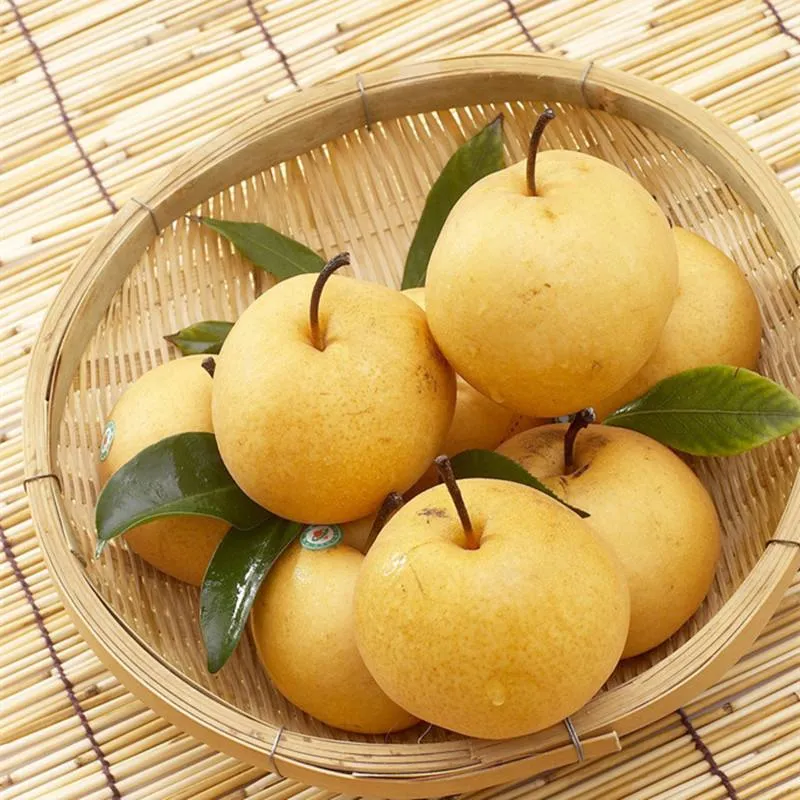
Sophie, 29: "I try to maintain a healthy lifestyle, so fruits and vegetables are a must in my diet. Once, I saw an Asian pear in the store and decided to try it, knowing it's healthy and low in calories. The pear was delicious and juicy. Now it's a regular on my table, and I recommend it to my friends."
Claire, 37: "I love its pleasant taste and juiciness. I buy it often because I have digestive issues, and the fiber in nashi pears helps cleanse the intestines. Another plus—low calories. Girls who want to lose weight, take note!"
Emma, 24: "Pears aren’t my favorite fruit, but I buy them for my parents and sister. Occasionally, I’ll have a slice. The taste is sweet and pleasant, the flesh is very juicy—best eaten sliced. There are a few brown seeds, but not many, and the core is small. The aroma is classic pear-like."
Conclusion
The Asian pear (nashi) stands out not only for its excellent taste and appearance but also for its numerous health benefits for children and adults. The fruit is used in juices, jams, desserts, pies, pancakes, salads, sauces, and even roasted or smoked dishes.







